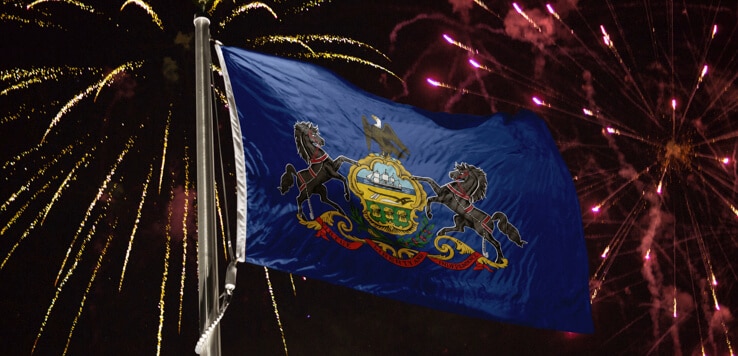Two years ago Pennsylvania was pilloried by gambling industry advocates and analysts for enacting a sports betting tax rate of 36% they denounced as unrealistically exorbitant.
Now it’s earning respect from independent analysts who suggest other states might have something to learn from it.
The Morgan Stanley investment firm issued a report in November citing Pennsylvania’s healthy sportsbook market as a reason to expect average tax rates across the nation to go higher in newly legalized states.
“Pennsylvania has the highest tax rate (excluding states run by the lottery) at 36 percent, which many including ourselves expected to significantly constrain market size. However, the market has been a relative success, so we expect future state legislators to push for higher tax rates,” said the report, 2025 U.S. Sports Betting Market Forecast.
Tax revenue beats New Jersey, even if handle doesn’t
The state’s sports betting revenue figures for December and the full year of 2019 are to be released later this week. In November, Pennsylvania’s betting handle reached $316.5 mm, with $5.3 mm in government tax revenue collected from that 36% rate.
That netted some $1.3 mm more for the state than did sports betting in New Jersey, even though that neighboring state’s more mature market with more operators handled some $246 mm more in wagers.
In its own U.S. Sports Betting Outlook 2020 issued last week, Gambling Compliance, an independent research firm, forecast Pennsylvania newly forming a “power trio” with New Jersey and Nevada at the top tier of states for revenue.
“We forecast Nevada, New Jersey and Pennsylvania to collectively account for 55 percent of a total U.S. betting market worth $1.51 billion in 2020, with Pennsylvania’s annual revenue more than doubling to surpass $200 million,” said Gambling Compliance.
So what happened to change the outlook in Pennsylvania? Why all the hand-wringing and scoffing in 2018, which has turned into optimism in 2020? Just this past October, former New Jersey Gov. Chris Christie was still calling Pennsylvania’s experience with sports betting “a rolling dumpster fire” that other states should learn from in the opposite direction.
First, by comparison to New Jersey, the market took a long time to start moving in Pennsylvania, where regulators have a reputation for moving more slowly and cautiously.
For many months in 2018, casinos failed to act on an opportunity to apply for a sportsbook by paying a $10 mm fee, and there was widespread speculation that they were all paralyzed by that fee and the tax rate.
But one by one in late 2018 and 2019 the dominoes fell, as operators did not want to get left behind the competition. The first sportsbook within a casino opened at Penn National’s Hollywood Casino in November 2018, and now 10 of the 12 casinos have them.
Many executives cited how, even if they didn’t expect to make much direct profit from sports betting, it would attract new patrons who would benefit other casino activity. The Morgan Stanley report estimated that table games, for instance, get a 7% revenue bump from the presence of a sportsbook.
Yes, size really does matter
James Kilsby, managing director of Gambling Compliance, also said the state’s population size — nearly 13 million — helped overcome the tax rate, which is more than twice as high as that of any state where the lottery does not run sports betting.
“The reality is that in big, highly coveted markets — states with bigger populations like Pennsylvania — operators are more likely to be willing to pay slightly higher tax rates and fees to access that bigger market,” Kilsby said.
The other thing that has helped Pennsylvania is that like New Jersey — and unlike the still bigger state of New York — the legislature and governor recognized from the outset the importance of online betting, which is driving more than 80% of the market.
Once the first online/mobile site launched in May 2019, others soon followed, and now there are eight options, with more to come in 2020.
Online success in Pennsylvania on top of that in New Jersey and elsewhere is a key reason that Gambling Compliance and Morgan Stanley are more bullish about the future of the U.S. sports betting market than they were a year ago.
“We were pretty confident states would legalize and regulate sports betting [in the wake of the May 2018 U.S. Supreme Court decision allowing it], but there was a question if they would allow mobile as a first step or proceed more cautiously,” Kilsby said.
Now that Pennsylvania has joined New Jersey in showing mobile betting’s success, new states are latching on, with nine of 11 states that legalized in 2019 including some type of mobile component in their legislation.
It remains uncertain if others will boost tax rates
There is still a question, though, of the extent to which others will follow Pennsylvania’s model with fees and tax rates. That trend has yet to show up, though Morgan Stanley expects it.
It predicted a “blended tax rate,” now averaging 15.1% across states, will rise to 17.5% as other states recognize how Pennsylvania is collecting substantial government revenue with little sign of detriment to the market.
Illinois followed Pennsylvania to a certain extent with 2019 legislation imposing fees of $10 mm to $20 mm on operators, but at just a 15% tax rate.
But another large state, Michigan, opted in recent legislation to set a tax rate of just 8.75% with far more modest fees of $150,000.
“The reality is different states are going to do different things,” Kilsby said.
But just as real, you probably won’t hear the same criticism of Pennsylvania you once did.
Photo by Derek Brumby / Shutterstock.com






